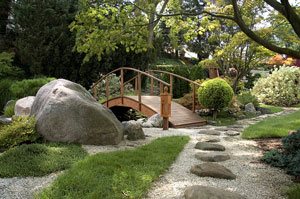
Story: Catherine Stewart, FAILDM FAIH
Oriental gardens have both tranquillity and gentle vitality that soothe and replenish the spirit. Often symbolic representations of natural landscapes, they build essential connections between us and our environment in a beautiful, understated way. This kind of garden design is not about overt statements of wealth, but about using a balance of sky and earth, of detail and simplicity, and of weight and delicacy to engage our senses.
Japanese garden design — the most popular style of oriental design in Australia — begins with a basic principle that all natural objects have inherent spirituality, including rocks, hills, water and trees. Traditional gardens evolved in several ways, which all manage to look disarmingly simple while tightly controlling the way they are viewed and experienced. Unlike Western gardens, there is no indiscriminate wandering.
Japanese often stroll gardens that surround a large lake. Tea gardens take garden visitors on a symbolic journey along paths of changing direction, through gates and up and down steps until, finally, arriving at a place of purification by water before entering the tea house pavilion. Zen gardens begin with the spirituality of natural objects but impose upon them a discipline that encourages self-examination and meditation.
Creating an oriental or Japanese-style garden is not just about buying a stone lantern or planting some bamboo. Rather than beginning with the idea of designing a space, imagine designing a journey, both physical and spiritual, that you create using particular elements.
Opt for natural materials
Although many Eastern countries such as Japan and China are now masters of manufacturing, their gardens do not reflect this at all. Nature is king, with materials such as stone, timber, bamboo and gravels favoured rather than concrete, ceramics and plastics. This gives a garden both a timeless quality and, even quite soon after construction, a feeling of age and solidity. Your local stone, whether granite, limestone or sandstone, is the right choice, as it reflects your environment.
Achieve a sense of balance
Rather than the symmetry preferred in Western designs, oriental gardens use balance and contrast. The ‘weight’ of objects such as pavilions, plants and stone is balanced by open space; dark colours of painted timber or stone are juxtaposed with pale gravels and bamboo, and large stone slabs are interspersed with smaller pebbles and cobbles. Wild areas featuring steeper slopes and craggy rocks are balanced by very clipped and controlled shrubs.
Pay attention to the paving
Lawns are rarely part of oriental gardens, although be aware that areas of raked gravels can also be high-maintenance. Paving tends to be artistic arrangements of both large and small pavers and even some oddly shaped ones or cobbles in the mix. Paths often have changes of direction to force a different view and reveal a previously obscured focal point. Small timber decks make intimate level spaces for sitting.
Incorporate gentle slopes
Rather than terracing every part of the garden into flat areas, slopes are conserved and used to recreate, in miniature, the natural landscape. Both Japanese and Chinese gardens often climb from their entry point, taking the garden visitor through several layers of different gardens. Even gravel gardens are rarely level, as this is seen as unnatural.
Water elements are vital
From still ponds to roaring cascades, water, or at least the suggestion of it, is an essential part of these gardens. Ponds are usually naturalistic rather than regular geometric shapes. Small streams or water channels recreate a flowing (but never straight) river or you can simply use a bamboo pipe emptying into a beautiful stone water bowl. A dry watercourse, if cleverly built, can convey the same sense of energy without the complications of waterproofing and pumps.
Delight in the small details
When visiting a famous Japanese garden, it might seem at first that there is nothing much there in our Western sense of lots of focal points and drama, but after completing your garden journey, you’ll find you’ve taken dozens of photographs. The real magic is in myriad minute details, from a craggy boulder partly covered with moss to the delicate tracery of a deliberately placed winter branch silhouette or a clever combination of differently textured gravels and cobbles.
The garden must always work on three levels as you walk around it: the big picture as the eye sweeps around, middle distance of a few metres with balanced pictures of stone, timber and plants but, most importantly, in close up.
Embrace changing seasons
While Japanese gardens use predominantly evergreen plants such as bamboo and conifers, they always display some seasonal change, using autumn colouring trees, trees with colourful spring growth and flowering shrubs and perennials such as iris.
Choose plants with care
Bamboo is a natural first choice but there are several that you cannot grow in the ground because they will run amok. Golden and black bamboo (Phyllostachys species) must always be strongly contained. Some clumping bamboos such as giant timber bamboo (Dendrocalamopsis oldhamii) will grow 15 metres tall (which is ideal if you need to screen part of the garden) or you can opt for the more manageable Bambusa species, such as B. multiplex and B. Textilis, that grow to six metres. There are some Bambusa cultivars such as B. multiplex ‘Fernleaf’ and ‘Willow’ that are only about four metres tall and B. multiplex ‘Riviereorum’ is only 2.5 metres. The tiny fortune-inviting bamboo, Shibataea kumasaca, is a spreading groundcover about 500mm high.
Other plants to look for (depending on your climate zone and soils) are azalea, Japanese maple, iris, black pine, cherry, plum and crabapple blossom trees, sacred bamboo (Nandina) and camellia, although how you group and prune your plants is more important than which ones you choose.






